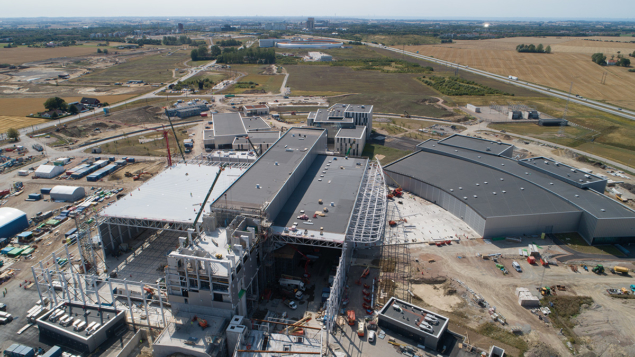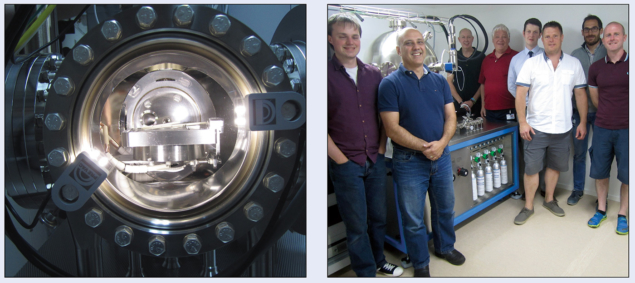Vacuum technologies are fundamental to the research mission of the European Spallation Source, a next-generation neutron-science facility under construction in Sweden. Joe McEntee talks to Marcelo Juni Ferreira, ESS vacuum group leader, about vacuum design, development and deployment in a ‘green-field’ big-science setting.

Neutron science 2.0 is evolving from concept to reality as construction progresses on the European Spallation Source (ESS), a €1.84 billion accelerator-driven neutron source in Lund, Sweden. ESS will deliver first science in 2023 and will, when in full operation, be the world’s most powerful neutron research facility – between 20 and 100 times brighter than the Institut Laue-Langevin (ILL) in Grenoble, France, and up to five times more powerful than the Spallation Neutron Source (SNS) in Oak Ridge, Tennessee, US.
This industrial-scale endeavour represents an amalgam of the most powerful linear proton accelerator ever built; a two-tonne, rotating tungsten target wheel (which produces neutrons via the spallation process); a reference set of 22 state-of-the-art neutron instruments for user experiments (of which 15 are under construction); and a high-performance data management and software development centre (located in Copenhagen). Here, Marcelo Juni Ferreira, vacuum group leader at ESS, tells CERN Courier how vacuum technologies are equally fundamental to the ESS’s scientific programme.
What does your role as ESS vacuum group leader involve?
I head up a 12-strong multidisciplinary team of engineers, scientists, designers and technicians who manage the international network of stakeholders developing the vacuum infrastructure for the ESS. Many of our partners, for example, make “in-kind” contributions of equipment and personnel rather than direct cash investments from the ESS member countries. As such, the ESS vacuum group is responsible for maintaining the facility’s integrated vacuum design approach across all of these contributions and all of our vacuum systems – the proton accelerator, target section, neutron beamlines and the full suite of neutron instruments that will ultimately support user experiments (see “ESS science, funding and partnership”).
In terms of specifics, what is meant by integrated vacuum design?
The integrated approach to vacuum design works on several levels. Cost reduction is a fundamental driver for ESS. The use of standard industry components where possible reduces maintenance and training requirements, minimises the need for expensive product inventory and, through a single framework agreement covering our in-kind partners and industry suppliers, we can work at scale to lower our overall procurement costs.

Another motivation is to help the vacuum group support the diverse vacuum requirements across the neutron instruments. The goal in each case is to ensure sustainable, economical and long-term operation of each instrument’s vacuum plant to minimise downtime and maximise research output. To make this possible, each of the neutron instruments (and associated beamlines) has its own “vacuum interface” document summarising key technical specifications and performance requirements – all ultimately aligned with the ESS Vacuum Handbook, the main reference source promoting the use of common vacuum equipment and standards across all aspects of the project.
So, standardisation is a big part of your vacuum strategy?
Absolutely. It’s all about a unified approach to our vacuum equipment as well as the procurement policy for any major hardware/software purchases for the accelerator, the target and the neutron instruments. Another upside of standardisation is that it simplifies the interfaces between the ESS vacuum infrastructure and the ESS safety and control plant – for example, the personnel protection, machine protection and target safety systems.
ESS recently took delivery of the Target Monolith Vessel (TMV), one of the facility’s main vacuum sections. What is the TMV and who built it?
The TMV represents the core building block of the ESS target station and was assembled by our in-kind partners at ESS Bilbao, Spain, working in collaboration with local manufacturers such as Cadinox and AVS. When ESS goes online in 2023, the TMV will enclose all of the target subsystems – the target wheel, moderator, reflector plugs and cryogenic cooling – in a vacuum atmosphere and, with the help of 6000 tonnes of stainless-steel shielding, also confine any activated materials and ionising radiation in case of a highly unlikely event, such as an earthquake or accident (see “ESS operational highlights”).
The monolith is an impressive and complex piece of precision engineering in its own right. The vessel requires exacting and repeatable alignment tolerances (±25 μm) for the target wheel, the moderator and reflector assemblies relative to the incident proton beam as well as the neutron-beam extraction system. Ahead of shipping, ESS Bilbao successfully completed the leak and vacuum tests on the TMV with satisfactory measurements of dew-point temperature, pressure rise and leak detection. The final pressure obtained was 1 × 10-6 mbar with a leakage < 1 × 10–8 mbar.l/s.
In terms of the TMV, how does your team design and build for maximum uptime?
The focus on project risk is a collective effort across all support functions and is framed by the ESS Strategic Installation and Test Strategy. With the TMV, for example, our design choices seek to minimise service interruptions to the scientific experiments at ESS. Put another way: each vacuum component in the TMV must offer the longest “time before failure” available on the market. In the case of the rough vacuum pumps, for example, this comes from Kashiyama Industries of Japan through ESS’s supplier Low2High Vacuum in Sweden – offering a dry vacuum pump that’s capable of 24/7, maintenance-free operation for up to three years. We’ve actually tested six of these units running at the laboratory for more than five years and none of them have required any intervention.
ESS science, funding and partnership
• Large-scale neutron facilities are routinely used by academic and industrial researchers to understand material properties on the atomic scale, spurring advances across a spectrum of scientific discovery – from clean energy and environmental technology to pharma and healthcare, from structural biology and nanotech to food science and cultural heritage.
• ESS is a pan-European project with 13 European nations as members: the Czech Republic, Denmark, Estonia, France, Germany, Hungary, Italy, Norway, Poland, Spain, Sweden, Switzerland and the UK.
• Significant in-kind contributions of equipment and expertise – from more than 40 European partner laboratories – are expected to finance more than a third of the overall construction costs for ESS.
• ESS will deliver its first science in 2023, with up to 3000 visiting researchers expected every year once the lab is fully operational.
Smart choices like this add up and result in less maintenance, reduced manual handling of active materials (e.g. pump oil) and lower cost per unit life-cycle. Similar thinking informs our approach regarding the TMV’s vacuum “plumbing”. The use of aluminium gaskets and clamps, for example, streamlines installation (compared with CF flanges) and takes into account their low neutron activation in the case of maintenance removal and reassembly ahead of resumed operations (with hands-on manipulation being faster and simpler in each case).
What are the biggest operational challenges in terms of preparing the TMV for high-reliability vacuum performance?
The major effort on the vessel was – and still is – to qualify all in-vacuum parts and connections in terms of their leak rates, pressure-code requirements and surface finishing. This includes the water-cooled shielding blocks, hydrogen-cooled moderator/deflector, and the helium cooling unit for the rotating tungsten target wheel (which employs a ferrofluidic sealing system). It’s a huge collective effort in vacuum: there are more than 1000 flanges, around 20,000 bolts and 6000 tonnes of load in the fully configured TMV (which measures 6 m internal diameter and 11 m high).
There will be two possible modes of TMV operation, with the target residing in either high vacuum or helium at slightly below atmospheric pressure. What’s the rationale here?
One of the high-level design objectives for ESS states that the TMV should be built to last for 50 years of operation while satisfying all performance and safety criteria. Our initial simulations showed that “cleanliness” of the volume surrounding the collisions of the proton beam and the tungsten target wheel will be essential for slowing material degradation and therefore delivering against this objective. What’s more, the specification of a 5 MW proton beam means that secondary gamma and neutron radiation will be produced as a side-effect of the spallation process, further emphasising the need for a controlled environment as well as appropriate cooling of the shielding blocks to counter radiation-induced heating effects.
ESS operational highlights
Fundamental principles

• At the heart of the ESS is a linear accelerator that produces up to a 5 MW beam of 2 GeV protons, with the bulk of the acceleration generated by more than 100 superconducting radio-frequency (RF) cavities.
• These accelerated protons strike a rotating tungsten target wheel (2.6 m diameter) to produce a beam of neutrons via nuclear spallation – i.e. the impact on the tungsten nuclei effectively “spalls” off free neutrons.
• The target wheel rotates at 23.3 rpm and is cooled by a flowing helium gas system interfaced with a secondary water system.
• The spalled neutrons pass through water premoderators, a supercritical hydrogen moderator (cooled to about 17 K) and a beryllium-lined reflector – all of which are housed in a replaceable plug – to slow the neutrons to useful energies before distribution to a suite of 15 neutron-science instruments.
• The TMV has an Active Cells Facility to perform remote handling, disassembly and storage of components that are taken out of the monolith after reaching the end of their lifetime; steel shielding blocks prevent the escape of neutron/gamma ionising radiation.
TMV vacuum considerations
• The TMV is designed to accommodate various leak-rate loads, including: outgassing of vacuum components; air leaks into the vacuum vessel; water leaks from internal piping plus humidity and condensation present during operations and pump down; and helium leaks from the target wheel.
• Total gas in-leakage is critical and, in conjunction with the capacity of the turbomolecular pumping system, will determine not only the TMV operating pressure but also the refrigeration capacity for the cryo-condensing coil for pumping of potential water leaks.
• In vacuum mode, TMV pressures < 10–4 mbar will be required for interfacing with the UHV environment of the proton accelerator (i.e. to keep gas flows into the accelerator section to an acceptable level).
• TMV vacuum components (including polymer seals) must be compatible with operation up to 35 °C in harsh gamma/neutron radiation environments.
Operationally, the optimal mode of operation will be high vacuum (< 10–4 mbar), which will negate the need for a proton beam window between the proton accelerator and the target. This, in turn, will lower the annual operating costs. Other advantages include up to 1% improved neutronic performance, reduced beam scattering on the TMV components (and therefore less heat load and radiation damage), as well as a cleaner image for the beam imaging diagnostics.
Nevertheless, we will design and build a proton beam window, so that it is ready to install for operation under helium should an unanticipated issue arise with the TMV vacuum. Worth noting that in this “helium mode” a pump-and-purge capability is provided to ensure high helium purity (> 99.9%).
What lessons can other big-science facilities learn from your experiences with the ESS vacuum project?
With ESS we are entering new territory and the reliability of all our components – vacuum and otherwise – requires close collaboration as well as consistent communication on all levels with our equipment vendors and in-kind partners. Operationally, there’s no doubt that the TMV and the other ESS vacuum systems have benefited from our dedicated vacuum laboratory – one of the first in-kind hardware shipments back in 2015 – and our efforts to recruit and build a skilled team of specialists in those early days of the project. The laboratory includes test facilities for vacuum integration, gauge calibration and materials outgassing studies – capabilities that allow us to iterate and optimise field solutions in good time ahead of deployment. All of which ultimately helps us to minimise project risk, with technical decisions informed by real-world testing and not just prior experience.





